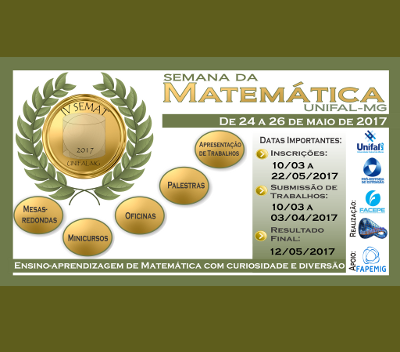Study of Some Balls in Space Rn
Keywords:
Métricas equivalentes, Espaços Rn, Desigualdade Elementar, Desigualdade de Holder, Desigualdade de MinkowskyAbstract
In this work it presents different metrics in Rn, not just the usual ones, known as module metrics, Euclidian, and maximum metrics, which are metric of the p metric case, with p in[1, ∞]. More precisely, it is a study about the sequence in function of p in which, for each fixed p, a different metric is obtained, for example, the Euclidean and module metrics are only particular cases for p = 1 and p = 2, respectively, since the maximum metric is treated as p = ∞. It will be shown that this sequence of functions dp converges to the maximum metric when p tends to infinity. In this way, the rules | · |p e | · |∞ and demonstrated that, in fact, they are metric for the set Rn. To prove this result it is necessary to state and demonstrate three important inequalities: Elementary Inequality, H¨older Inequality and Minkowsky Inequality. Then, it is shown that when p tends to infinity, the norm | · |p converges to the standard k · k∞. At the end, it is concluded that all the metrics presented here are equivalent independent of the value p, in this way, one has the guarantee that whichever one of these metrics is obtained similar results on the space Rn. These results are adaptations of similar results for infinite-dimensional spaces presented in Kreyszig (1978), with the last result being left as an exercise.
References
DOMINGUES, H. H. Domingues.Espaços Métricos e Introdução à Topologia. São Paulo:
Atual, 1982.
KREYSZIG, E. Introductory functional analysis with applications. New York: John Wiley &
Sons, 1978.
MUNKRES, J. R. Topology, 2 ed., Upper Saddle River: Prentice Hall, 2000.
Downloads
Published
How to Cite
Issue
Section
License
Proposta de Política para Periódicos de Acesso Livre
Autores que publicam nesta revista concordam com os seguintes termos:
- Autores mantém os direitos autorais e concedem à revista o direito de primeira publicação, com o trabalho simultaneamente licenciado sob a Licença Creative Commons Attribution que permite o compartilhamento do trabalho com reconhecimento da autoria e publicação inicial nesta revista.
- Autores têm autorização para assumir contratos adicionais separadamente, para distribuição não-exclusiva da versão do trabalho publicada nesta revista (ex.: publicar em repositório institucional ou como capítulo de livro), com reconhecimento de autoria e publicação inicial nesta revista.
- Autores têm permissão e são estimulados a publicar e distribuir seu trabalho online (ex.: em repositórios institucionais ou na sua página pessoal) a qualquer ponto antes ou durante o processo editorial, já que isso pode gerar alterações produtivas, bem como aumentar o impacto e a citação do trabalho publicado (Veja O Efeito do Acesso Livre).

